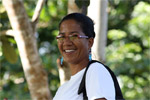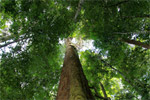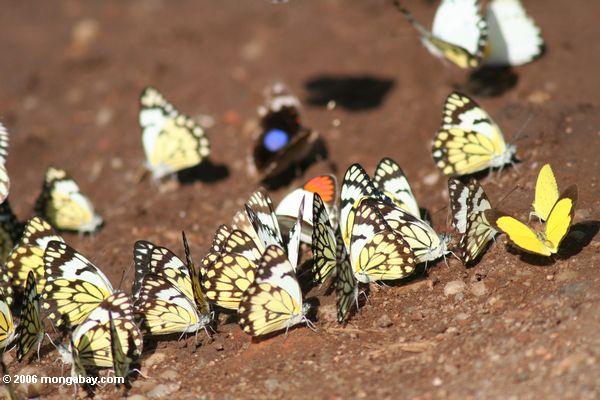Butterflies feeding on minerals in Uganda. Photo by: Rhett A. Butler.
If done well, REDD+ projects (Reducing Emissions from Deforestation and Forest Degradation) may not only save carbon rich forests, but also protect embattled biodiversity. But what’s the best way to ensure both and carbon and species are preserved under REDD+, a program that proposes to pay nations to keep forests standing? A new study in mongabay.com’s open access journal Tropical Conservation Society (TCS) argues that a one-size-fits-all approach to monitoring biodiversity in REDD+ projects would not only be difficult to develop, but would likely fail given vast differences in forest ecology and threats worldwide. Instead local sites should develop monitoring programs based on a generally approved roadmap.
“The impact of REDD+ on biodiversity could potentially be negative if low-carbon, high-biodiversity forests are replaced with high-carbon, low-biodiversity forests; or protection of high-carbon forest in one area leads to displacement of threats to other, more biodiverse, forests,” the researchers warn adding that this possibility, even if remote, raises the need for biodiversity monitoring across REDD+ projects.
In their paper the researchers directly oppose an earlier study, also in TCS, that argued for standardized biodiversity monitoring based on camera traps and acoustic monitoring of bats. While researchers admit both methods could play a role in monitoring, they should not be wholly depended on.
“Our analysis indicates that camera trapping for large mammals and acoustic monitoring for bats can be effective monitoring solutions in some tropical areas, but that the model biodiversity monitoring protocol […] will not be suitable for use in all forests, and may not be the most (cost) effective approach in others,” they write.
Going further the authors argue that any attempt at a one-size-fits-all monitoring system will likely prove problematic.
“The forests of the world—ranging from boreal coniferous forests to tropical jungles—differ enormously in their character, species assemblages, ecological interactions, nature and intensity of anthropogenic threats faced. The practicalities and costs of conducting research in these forests also differ,” they write. For example, different forests have unique key species, often requiring a different set of monitoring tools.
Instead the researchers recommend that biodiversity monitoring regimes reflect local conservation goals, incorporate detailed information about the particular forest, monitor several reflective species, track the impacts of management on the ecosystem, and define ahead of time baseline biodiversity in the forest. The authors specifically point to the need to track habitat condition and any disturbance to the forest in order to draw a direct line between observed changes in biodiversity to human action.
“It is vital that REDD+ ecological monitoring programs be tailored to a particular project’s aims and the forest habitat in question, which requires detailed knowledge of the forest habitat and its associated biodiversity,” the authors write. “Such an approach should provide more concrete answers to questions relating to the assumed biodiversity benefits of REDD+ emission reduction management activities.”
CITATION: Harrison, M. E., Boonman, A., Cheyne, S. M., Husson, S. J., Marchant , N. C. and Struebig, M. J. 2012. Biodiversity monitoring protocols for REDD+: can a one-size-fits-all approach really work? Tropical Conservation Science Vol. 5(1):1-11.
Related articles
Global rainforest carbon map released online
(03/18/2012) Researchers have posted carbon stock data for the world’s tropical forests on ArcGIS Online, a web-based mapping platform developed by Esri.
Colombian community leader talks about REDD

(02/21/2012) A pioneering project to reduce deforestation and forest degradation in a former conflict zone in Colombia has won gold certification under the Climate, Community, and Biodiversity (CCB) standard. The accreditation will help local communities access carbon finance in their efforts to safeguard biologically-rich forests. The project is located in Colombia’s Darien region, near the border with Panama. The area is part of the Chocó, the rainforest ecosystem that runs along the Pacific coast of Colombia and Ecuador but has been heavily affected in places by deforestation. Everildys Cordoba is the project’s coordinator on the community side. Cordoba grew up in Penaloza, a small town not far from the Caribbean coast of Colombia and the country’s border with Panama. But in 1998, she was forcibly displaced by armed actors. Today, she has returned to her land to lead the project.
‘Gold’ standard for REDD forest conservation project in Colombia’s Choco
(02/15/2012) A pioneering project to reduce deforestation and forest degradation in a former conflict zone in Colombia has won gold certification under the Climate, Community, and Biodiversity (CCB) standard. The accreditation will help local communities access carbon finance in their efforts to safeguard biologically-rich forests.
10 rules for making REDD+ projects more equitable
(02/02/2012) The International Institute for Environment and Development has published a new report on benefit distribution under Reducing Emissions from Deforestation and Forest Degradation (REDD+) programs. The report includes a top ten list of recommendations to ensure REDD+ works for poor communities that live in and around forests.
Logging of primary rainforests not ecologically sustainable, argue scientists

(01/25/2012) Tropical countries may face a risk of ‘peak timber’ as continued logging of rainforests exceeds the capacity of forests to regenerate timber stocks and substantially increases the risk of outright clearing for agricultural and industrial plantations, argues a trio of scientists writing in the journal Biological Conservation. The implications for climate, biodiversity, and local economies are substantial.
Rainforests need massive finance, but REDD must be well-designed to succeed

(01/17/2012) A proposed mechanism to reduce greenhouse gas emissions by protecting tropical forests has evolved considerably since it started to gain momentum during the 2005 climate talks in Montreal. Known then as ‘avoided deforestation’, the concept was simple: pay tropical forest countries to keep their forests standing. Since then, the concept has broadened to include activities beyond strict forest conservation, including reducing logging and fire, protecting carbon-dense peatlands, encouraging better forest management practices in existing forest concessions, and promoting reforestation and afforestation. A prominent voice in the discussion around REDD since its inception is the environmental activist group Greenpeace. Mongabay recently caught up with Roman Czebiniak, Greenpeace International’s Political Advisor on Climate Change and Forests, for an update on the organization’s position on REDD as well as recent developments in the forest carbon policy arena.
